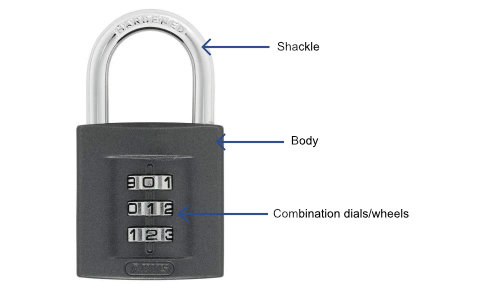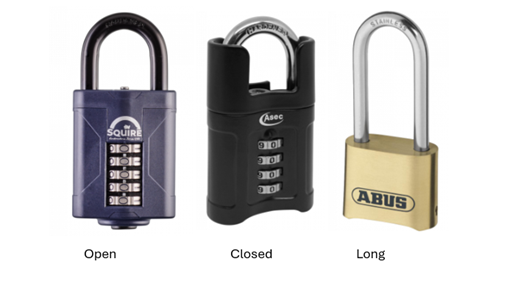Combination padlocks offer a keyless solution for securing personal belongings like luggage or toolboxes, as well as shared spaces where multiple people need access. They're especially useful when managing access without distributing physical keys. Whether you're installing these locks indoors or outdoors, understanding their components and functionality is essential. In this guide, we'll walk you through the basics of combination padlocks, including their parts, how to open them, resetting the code, troubleshooting common issues, and considerations for upgrading or replacing them. First, let's cover the basic anatomy of a combination padlock. Externally, you'll find three primary parts: the shackle, the body, and the combination dials. Shackle: The curved or straight piece at the top of the lock that loops through a hasp, chain, or bolt. Shackles can vary in material—such as braided steel cable—and may be fixed or removable. Some advanced designs even feature a "shackleless" option where the shackle is entirely concealed within the body. Body: This houses the locking mechanism and holds the shackle in place when locked. Bodies come in various materials like stainless steel, aluminum, or brass, and can differ in size, shape, and finish. For combination locks, the body protects the internal components while providing durability. Combination Dials: These are typically located on the front, side, or underside of the lock. Most combination locks have 3, 4, or 5 dials, with more dials offering higher security due to the vast number of possible combinations. The body material and shackle type also contribute to the overall security rating. To unlock a combination padlock, you need the correct code. Follow these steps: Step 1: Align the first dial with the first digit of the code. Step 2: Rotate the second dial to match the second digit. Step 3: Do the same for the remaining dials until the entire code is entered. Step 4: Pull the body and shackle in opposite directions. Step 5: Rotate them apart to create enough space to remove the lock from the secured item. A tip from our locksmith: Some models might require pressing down on the shackle slightly after entering the code to allow it to open. Changing the code on a combination padlock is straightforward. Let's walk through the process using an example. We'll demonstrate with a four-wheel ABUS 158/50 padlock, known for its zinc die-cast body and hardened steel shackle. This model is ideal for medium-risk applications and securing valuable items. Its 8mm shackle is open, making it perfect for use with an ABUS 100 hasp and staple or similar models. Step 1: Enter the preset code to open the padlock. Step 2: Locate the reset screw at the bottom of the lock. Step 3: Use a flathead screwdriver to turn the reset screw 90 degrees counterclockwise. Step 4: Adjust the dials to your desired combination. Step 5: Turn the reset screw back 90 degrees clockwise to finalize the new code. Finally, close the padlock and randomize the dials to prevent unauthorized access if someone finds the lock with the code visible. Be sure to note the new code and share it only with authorized individuals. Avoid writing the code near the lock itself, as this compromises the security benefits of a combination lock. Problem 1: Forgotten Code – If you've lost the combination, the simplest solution might be to cut the shackle with bolt cutters and purchase a new lock. However, professional locksmiths can often retrieve the code or replace the lock without damaging it. Problem 2: Stuck Mechanism – Apply a PTFE or graphite powder lubricant to free the moving parts. Regular maintenance is crucial to keeping your lock functional. Lubricating the wheels, shackle arms, and adjustment screws can help avoid jams. Problem 3: Misaligned Dials – Ensure the dials are perfectly aligned; misalignment can prevent the lock from opening. Remember, proper maintenance is key to extending the life of your padlock. Regular lubrication, especially in harsh environments, ensures smooth operation over time. When it's time to replace your padlock, consider factors like shackle size, location, usage frequency, and security level. For instance: By carefully selecting a padlock that fits your current and future needs, you can enhance security while ensuring ease of use. Regular maintenance will keep your new lock reliable and efficient. Whether you're setting up a new padlock or replacing an old one, understanding its components, how to operate it, and maintaining it properly is essential. Our range includes fingerprint locks, standard key locks, and hasps with staples. If you need further assistance or can't find what you're looking for, feel free to reach out to our customer service team at [email protected] or call us at 01305 263300. Barium Peroxide Formula,Barium Peroxide,Industrial Grade Barium Peroxide,High Purity Barium Peroxide Vietnam Fine Chemical Factory , https://www.finechemvina.com

How to Open a Combination Padlock
Resetting a Combination Padlock

Common Issues and Solutions
Upgrading Your Padlock
Combination Padlock Security